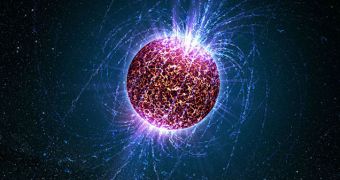In a new scientific study, investigators propose that neutron stars may be forced into instantly collapsing or exploding by short-term accumulations of what is known as “vacuum energy.”
Astrophysicists believe that the stuff can accumulate in just milliseconds, and argue in the research paper accompanying the investigation that this is enough to make the star unstable.
Neutron stars are remnants of a lot more massive stars, that reached the end of their burning cycle when they exhausted their supply of hydrogen gas. They then exploded into supernovas.
Only two type of structures usually result from large supernova explosions, neutron stars and black holes. Both are basically a crushed version of the collapsed core of the initial star.
Neutron stars can turn into either pulsars or magnetars, but this is not always the case. At times, they simply remain bodies that release massive amounts of neutrons.
As far as the new study goes, one might suggest that the notion of vacuum energy is a new one. This is however not the case, since quantum physics has been proposing its existence for year.
In this theory, this form of energy develops in a space that is filled with particles rapidly going in an out of existence, colliding with and annihilating each other as they do so.
Generally, such an energy is of very weak intensity, but astrophysics experts believe that the strong gravitational and magnetic fields that develop around neutron stars may lead to rapid build-ups of the stuff, lasting only milliseconds.
Brazilian theoretical physicists say that the neutron stars – most of which are not larger than 20 kilometers in diameter – contain highly-crushed matter of massive density.
A spoonful of neutron matter from such a stellar object would weigh in excess of 100 million tons. The new work was led by expert Daniel Vanzella, who is based at the University of Sao Paulo in Sao Carlos.
He and his group believe that the conditions in and around neutron stars are sufficient to “wake up” this vacuum energy, by allowing it to accumulate exponentially over brief periods of time, Space reports.
Therefore, the speed of accumulation is directly related to the size and mass of the neutron stars themselves, the research team believes.
About “95 percent of the energy of the Universe is in forms which we don't know what they are – they are generically called 'dark matter' and 'dark energy',” Vanzella explains.
“In principle, there is plenty of room for new or yet-to-be-discovered fields in nature,” he goes on to say. The new study is published in the October 7 issue of the esteemed journal Physical Review Letters.

 14 DAY TRIAL //
14 DAY TRIAL //